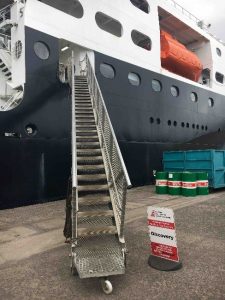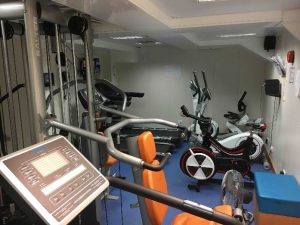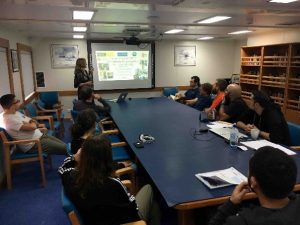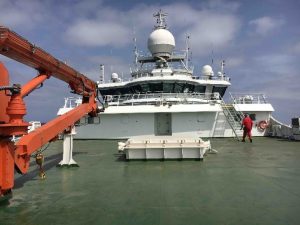 The Royal Research Ship (RRS) Discovery is our home for the month. We are currently about 200 nautical miles off the coast of Sierra Leone and will arrive at our first site tomorrow afternoon. The weather has been good – calm seas and the temperature is climbing towards 30oC. The past 4 transit days have given me lots of time to get to know the ship.
The Royal Research Ship (RRS) Discovery is our home for the month. We are currently about 200 nautical miles off the coast of Sierra Leone and will arrive at our first site tomorrow afternoon. The weather has been good – calm seas and the temperature is climbing towards 30oC. The past 4 transit days have given me lots of time to get to know the ship.
The Discovery is operated by the UK’s National Oceanographic Centre (NOC). The ship we are on was built in Spain and launched in 2012, but the name ‘Discovery’ goes back centuries to the British East India Company. The use of the name for exploration and research starts at the beginning of the last century when Robert Scott commanded the National Antarctic Expedition of 1901-1904. At one point, Scott and Shackleton sailed together to the Antarctic on the Discovery. In 1925 she was designated a ‘Royal Research Ship’ and the name has transferred to new research ships – in 1929 and 1962 and then our ship in 2013.
The Discovery is something of a tardis. It is nearly 100 m long and 20 m wide and is carrying 16 scientists, 2 research technicians, 21 crew members and 1 cadet, but it doesn’t seem crowded. You see most people at mess times, but otherwise you can spend a lot of time on your own. The ship has 9 decks, which have confusing names. Only 3 of the lower decks extend the full length of the ship. The upper decks cover only the front of the ship.
Starting at the bottom of the ship, the Tank Top lies above the fuel and ballast tanks and houses the engines. A discontinuous Lower Deck houses various control areas for running the engines and other things. A lot of water is carried for ballast and the ship has a clever system of sloshing water from side to side to mitigate roll or to provide counterbalance when using the cranes to load the ship. We are hoping to get a tour of this deck toward the end of the trip, but Andy – the Chief Engineer – was kind enough to show me around part of it this morning.

The Main Deck is defined as the lowest deck above the water line that extends the full length of the ship. On the Discovery it houses the gym, laundry room, gravimeter and most of the accommodation (cabins) for the scientists. There are also a number of workshops down on this deck.
Most of the scientific labs are on the Upper Deck, which is where we spend the majority of our time. Chemistry labs and wet rooms are where samples from the ocean, dredging, and so forth can be examined, but we are not using these facilities in this cruise. The OBS and OBM labs for this trip are towards the stern, with easy access to the open part of the deck where the instruments will be hauled onto the ship and into the main hangar area for storing. The computer and server rooms are housed in well-chilled areas and some crew cabins and the sick bay are on this deck. The garbage treatment and storage is also on this level – fortunately, we have little contact with this area.
The decks above the Upper Deck do not extend the full length of the ship. The Mezzanine Deck has a nice  conference room, library, video room, and bar and lounge. We are allowed two tins of beer or one small (175ml) bottle of wine a day. Most importantly, this level is where you find the galley, servery and mess. This is the deck you enter the ship from the gangplank.
conference room, library, video room, and bar and lounge. We are allowed two tins of beer or one small (175ml) bottle of wine a day. Most importantly, this level is where you find the galley, servery and mess. This is the deck you enter the ship from the gangplank.
The Boat Deck is where, as Senior Scientist, my room is and some of the officers’ cabins, including the Purser’s. The two life boats are stored on this level. Moving up a level is the Forecastle – pronounced fo’c’sle – Deck and it is primarily living quarters for the Captain, Principal Scientist (Kate Rychert), Chief Engineer, and other high-ranking officers. In case of emergencies, the muster station is at the aft of this deck.
Finally, the  Bridge is the highest deck and where the Captain and Officers control the ship. There is actually a deck of limited height below the Bridge that houses electrical and navigation equipment. This is the Navigation Bridge Deck, nicknamed ‘Middle Earth’, as only hobbits can stand up comfortably in the space.
Bridge is the highest deck and where the Captain and Officers control the ship. There is actually a deck of limited height below the Bridge that houses electrical and navigation equipment. This is the Navigation Bridge Deck, nicknamed ‘Middle Earth’, as only hobbits can stand up comfortably in the space.
Everything on the ship is fastened down. You soon learn that anything left unstable will end up rolling across to floor to a corner of the room.
There are monitors everywhere in the labs, showing our location and speed, but also sea conditions, water depth, the weather, and the way points. CC-TV also broadcasts video from the deck and winch areas. In a later blog I will describe more about the equipment on board this impressive ship.